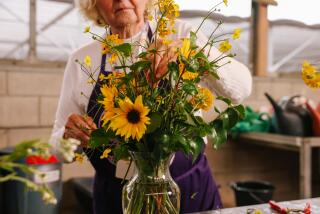Prima Donnas
- Share via
Petunias these days are hardly the same as those country garden varieties known to our parents and grandparents. After World War I, new types of petunias started appearing, but the favorites remained the small, floriferous and tough varieties, such as ‘Heavenly Blue’ and ‘Rosy Morn.’ Planted after the danger of frost was over, they would last into fall, and sometimes, if cut back, they would act as though they were perennials. It was also quite common for these older varieties to reseed themselves.
Today, many petunias are large, fussy prima donnas, beautiful but temperamental. To keep them happy, let them get their feet firmly established in the ground before they bloom; this way they better tolerate heat, drought and poor soil. This means planting in the next few weeks, or certainly before the end of April. But do not give them too rich a diet; this sends plants into vigorous, non-flowering growth.
There are many glorious ruffled and double petunias. For masses of color consider the multifloras with smaller flowers but more bloom; they are starting to make a comeback. If any of your petunias strikes your fancy, try making cuttings in the early fall.
God’s gift to the lazy gardener is the earthworm. By their constant burrowing and tilling, worms aerate the soil and help prevent erosion by opening it up so water penetrates deeply and does not run off. They are known to come out at night, pick up organic material and pull it back into the ground to feed on, leaving behind castings that are rich in fertilizer. With all this to consider, we might ask what we can do to attract earthworms. The answer is to provide them with organic mulch--the more the better--and water. Since a mulch holds moisture well, watering once a month is sufficient in normal weather.
Marigolds, one of the country’s most popular summer annuals, are available in many shapes and sizes, and quite a few have multicolored flowers. Burpee Seed Co. is noted for its work in developing a white marigold. The Inca series from Park Seed Co. comes in yellow, gold, orange or mixed and has a four- to five-inch bloom on a plant 14 inches tall. The ‘Crackerjack’ group of African marigolds grow 3 1/2 feet, while some of the French marigolds top off at nine inches. Incidentally, though called African and French, all marigolds are originally from Mexico and the Western Hemisphere. Seeds or plants can go into the ground as soon as the danger of frost is over.
Summer bulbs can be planted now. They are a good investment since most give much more color than spring bulbs. Tulips, daffodils, hyacinths and other spring bulbs often have only one stem of flowers, but summer bulbs such as dahlias, tuberous begonias and gloxinias bloom over many months. It is quite easy to save the bulbs from year to year and, as they multiply and are divided, to have more and more bloom. Most summer bulbs come from a climate in which it is dry in winter and wet in summer. Here, they need water but also good drainage. Other summer bulbs are cannas, caladiums, lilies, tuberoses and tigridias.






